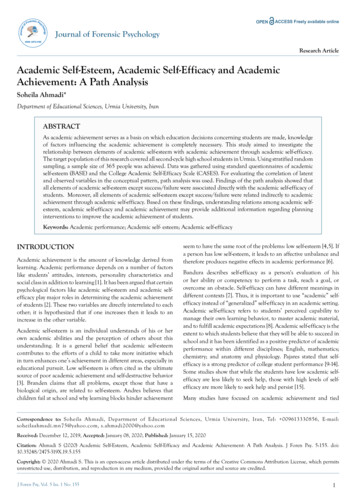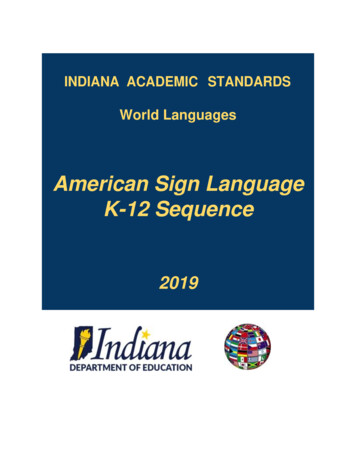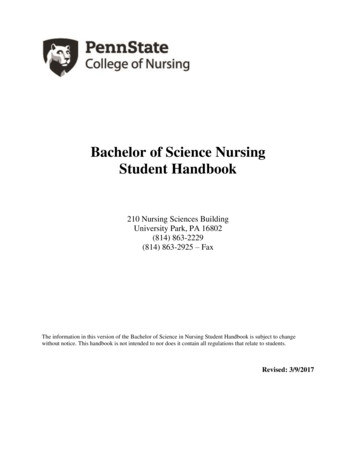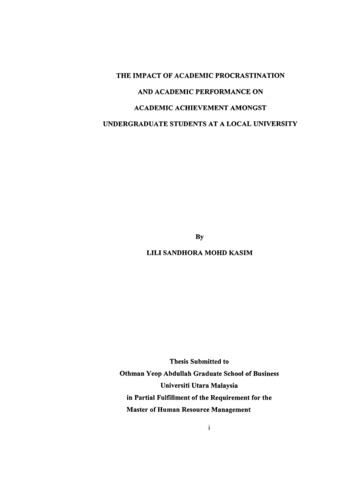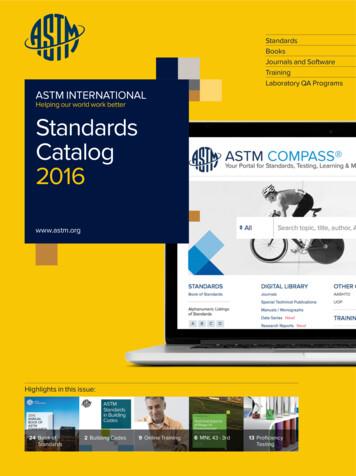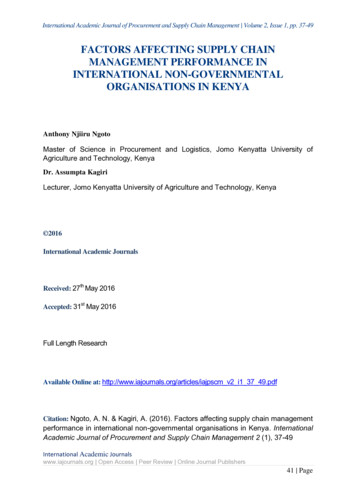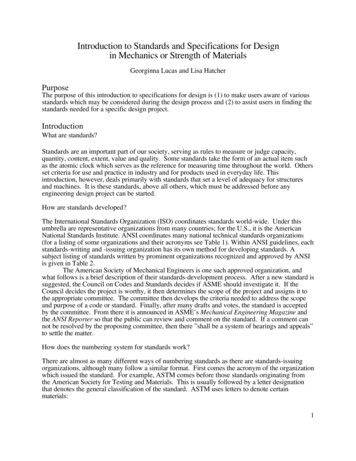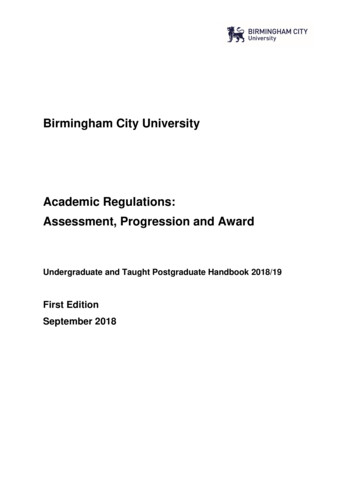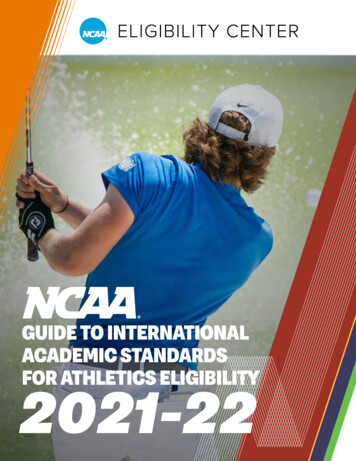
Transcription
GUIDE TO INTERNATIONALACADEMIC STANDARDSFOR ATHLETICS ELIGIBILITY2021-22
THE NATIONAL COLLEGIATEATHLETIC ASSOCIATIONP.O. Box 7110Indianapolis, IN 46207-7110317-917-6222ncaa.orgThe National Collegiate Athletic Association is a membership-driven organization dedicated tosafeguarding student-athlete well-being and equipping them with the skills to succeed on theplaying field, in the classroom and throughout life.We support learning through sports by integrating athletics and higher education to enrich thecollege experience of student-athletes and making college sports a pathway to opportunity. Morethan 1,100 NCAA members – mostly colleges and universities, but also conferences and affiliatedgroups – work together to create a framework of rules for fair and safe competition. Those rulesare administered by NCAA national office staff, which also organizes national championships andprovides other resources to support student-athletes and the schools they attend.Our diverse membership includes schools with student bodies that range from hundreds ofstudents to tens of thousands. The three-division structure creates a fair playing field forlike-minded schools and provides student-athletes with a wide spectrum of opportunities toparticipate in 90 championship events.College and university presidents and chancellors guide each division, supported by anextensive committee structure guided by athletics administrators, faculty and student-athleterepresentatives. Each division creates its own rules that follow the overarching principles ofthe NCAA.NCAA, NCAA logo and National Collegiate Athletic Association are registered marks of theAssociation and use in any manner is prohibited unless prior approval is obtained fromthe Association.Page 2
TABLE OF CONTENTSINTRODUCTION 4Authority 4Reconsideration 4ACADEMIC CERTIFICATION PROCESS 5Registration 5Official Document Requirements 5English Translation Requirements 5Where to Send Student Records 6For Additional Assistance 6HELPFUL INFORMATION 7Educational Tracks 8Resources 8Test Score Information* 8NCAA Division I 8NCAA Division II 8Other Test Information 11ALPHABETICAL LISTING OF COUNTRIES 12GUIDE UPDATES 15EXAMINATION BOARD ADDRESSES 557Page 3
INTRODUCTIONAuthorityAs set forth in the NCAA Division I and II Bylaws, the NCAA Eligibility Center is responsible forcertifying the academic and amateurism initial-eligibility of all incoming prospective studentathletes. Specifically, Division I Bylaws 14.1.2.5 and 14.3.5.4 and Division II Bylaws 14.1.2.4and 14.3.2.4 establish the authority for the Eligibility Center to administer the academicrequirements for prospective student-athletes who have an international education component intheir academic certification.In addition, Division I Bylaw 21.6.3.1 empowers the International Student Records Committee(ISRC) to assist in reviewing initial-eligibility standards for international students. Thecommittee is comprised of international academic experts from NCAA membership representingboth Division I and II schools. The current NCAA ISRC members are as follows:»Greg Gilbert, University of Findlay (Chair).»Josh Daume, Arkansas State University.»Heidi Leonard, King University.»Jim Stein, University of Hawaii, Mãnoa.»Hanna Lantz, Texas A&M University, Kingsville.The ISRC provides knowledge and expertise regarding international educational systems toestablish supplemental initial-eligibility policies and procedures, as stated in this Guide toInternational Academic Standards for Athletics Eligibility, which complement the NCAA Division Iand II bylaws. Only the Eligibility Center international academic certification staff has authorityto determine crediting and academic timelines. As part of this process, staff may reviewprofessional resources (e.g., ENIC), published information from the appropriate issuing body orgovernment (e.g., ministry of education), and/or other information on a case-by-case basis. Ifinformation is deemed to be inconclusive or unavailable, staff will not make a determination.ReconsiderationAn NCAA member school may request reconsideration of a previous decision (staff or committee)based on new and relevant information. The staff has discretion to determine whether themember school’s submission meets the threshold. If so, staff will reopen the review and render areconsideration decision; however, if not, staff will deny the reconsideration request.»Page 4If you are interested in NCAA Division III, please visit NCAA.org/d3 or contact theathletics office at a Division III campus for its initial-eligibility standards.
ACADEMIC CERTIFICATION PROCESSRegistrationCollege-bound student-athletes preparing to enroll in a Division I or II school must registerwith the NCAA Eligibility Center to ensure they have met amateurism standards and areacademically prepared for college coursework. Please direct all interested prospective studentathletes (PSAs) to eligibilitycenter.org for registration.Official Document RequirementsAcademic documents are required to assess the NCAA initial eligibility of a prospectivestudent-athlete.If a prospective student-athlete is attending school in a country where English is not considered anative language, all official documents must be submitted in the native language. A certified lineby-line English translation of all official documents will also be required to accompany all nativelanguage documents requested.The following documents are required to assess the NCAA initial eligibility of each prospectivestudent-athlete:»Transcripts for the ninth year of schooling and up.»Acceptable proof of graduation, as defined in the country-specific entries of this resource.The following documents may be requested to assess the NCAA initial eligibility of eachprospective student-athlete:»Transcript for year eight.»Graduation certificate/diploma.»Grading scale(s) with minimum passing grade from each school attended for the ninthyear of schooling and up.»Course completion dates on any documents requested.For a list of country-specific documents that may be requested in addition to those indicatedabove, please see the country-specific entry in this document.English Translation RequirementsComplete, literal word-for-word, line-by-line certified English translations for all documents inthe same format as the original documents are required. The information below further explainsthese requirements:»English translations must be provided by a person not related to or associated withthe student or the athletics department at the NCAA member school the college-boundstudent-athlete plans to attend.»The English translator must provide a letter, including any appropriate stamps or seals,explaining their qualifications as a translator.Page 5
»The English translator must provide full name, mailing address, telephone number, emailaddress or any other means by which the authenticity of the translation can be verified.»We recommended English translations be performed by a college or university instructorof the language or a professionally certified English translator.»English translations must accompany the original documents written in the nativelanguage.»English translations not in accordance with the above specifications will not be accepted.Where to Send Student RecordsThe following options are available for submitting academic records for international students.Before submitting any documents/transcripts, please ensure the student’s name and NCAA ID areindicated clearly on each submitted item. Note: The NCAA cannot return submitted documents.Direct upload to the student’s NCAA Eligibility Center account (available only to NCAAmember schools.)»Best practice; information is immediately attached to student’s account upon upload.Email: ec-processing@ncaa.org. Available only to international high schools, ministry offices,issuing bodies and translation services (for translations only). Please ensure the student’s nameand NCAA ID are included in the email’s subject line.»Note: Certified documents must be emailed from a school or official email address.Emails submitted from general email providers, such as Gmail, Yahoo, Hotmail, etc.,cannot be accepted.»Any emailed documents must be submitted as .pdf attachments (not password protected)to avoid processing delays or unaccepted documents.»Please allow two days for processing from date of email receipt.Mail: Please allow up to five days for processing from date of mail receipt.NCAA Eligibility CenterP.O. Box 7110Indianapolis, IN 46207-7110For Additional AssistanceNCAA Eligibility Center Customer Service:U.S. and Canada (except Quebec):877-262-1492 (toll free) Monday-Friday9 a.m. to 5 p.m. Eastern Standard timeInternational callers: 317-917-62228:30 a.m. to 5 p.m. Eastern Standard timeNCAA Eligibility Center InternationalContact FormFax number: 317-968-5100Page 6Overnight/Express Mailing Address:NCAA Eligibility CenterInternational Certification Processing1802 Alonzo Watford Sr. DriveIndianapolis, IN 46202
HELPFUL INFORMATIONNote: The country entries found in this resource are intended to provide country-specificinformation only. Each entry includes the information typical for that country; however, alleducational paths can differ within each country and are subject to change. The informationbelow should be considered supplemental to the policies and procedures used to complete anacademic certification.Please contact the NCAA Eligibility Center with any questions regarding a specific prospectivestudent-athletes and their individual educational paths.»For all rules pertaining to NCAA Division I and II academic initial-eligibility requirements(including, but not limited to, time limitations for core-course completion; what typeof courses are eligible for use in an academic certification; and the overall academicrequirements for both Divisions I and II), please see NCAA Division I and II manuals(Bylaw 14.3.).»Effective April 2016, all students (including international students) are eligible for theEarly Academic Qualifier Exception (see Bylaw 14.3.1.1.2).»Due to the nature of education systems around the world, it is possible for a prospectivestudent-athlete to study in an educational system that is not reflected in the country entryin this guide.For example, a school in Venezuela may be a French school offering a French Diploma.The country entry of France should be referenced when reviewing documents from thisschool, rather than the country entry for Venezuela. The most common occurrence ofthis would be earning a General Certificate of Education (GCE), General Certificate ofSecondary Education (GCSE) or International General Certificate of Secondary Education(IGCSE) in almost any country. Generally, the information in the United Kingdom(England and Wales) country entry would apply to these documents.»For students who initially enroll in year/grade nine on one academic calendar andmove to a school on a different academic calendar, the student’s core-curriculum timelimitation will remain on the academic calendar the student began year nine. Forexample, a student begins year nine in Australia (which runs on a February-Decemberacademic calendar) but completes schooling in the U.S. (which is on a September-Juneacademic calendar). The students’ core-curriculum time limitation would remain on theAustralian academic calendar.»Eighth grade coursework completed in a 10-year or 11-year educational system can beused for initial-eligibility certification if the coursework meets the NCAA definition ofa core course. This course information must be submitted to the Eligibility Center forreview to determine if the course meets the definition of an NCAA core course. Eighthgrade coursework taken in a system that is 12 years or greater will not be considered inan academic certification.Page 7
»Students who have attended school in the following United States territories will betreated as domestic students for NCAA initial-eligibility purposes: American Samoa,Guam, Puerto Rico and the U.S. Virgin Islands.»Students enrolled in schools abroad that are under U.S. sponsorship and offer thestandard U.S. curriculum, including those that serve both U.S. and non-U.S. citizens, willbe certified as domestic students (e.g., American schools overseas, Department of DefenseDependents Schools (DODDS)) for NCAA academic initial-eligibility purposes.»Unpublicized changes in state or national grading scales may occur after publicationof the most recent edition of the NCAA’s Guide to International Academic Standards forAthletics Eligibility. In addition, you may receive academic credentials not included inthis International Guide. Member schools are advised to send any differing academiccredentials or grading scales to the Eligibility Center.»When a particular document or grading scale is no longer in use by an internationaleducational system, the document or grading scale will be removed from the Guideto International Academic Standards for Athletics Eligibility five years after thediscontinuation of the document or grading scale.»When specific core-course credits are not indicated on a transcript, the Eligibility Centerwill credit based on the Carnegie unit system (weeks of attendance multiplied by hoursof study per week) and provide one (1.0) credit per year in each of the following courses:English, native language and mathematics; with a half-credit per year in the followingcourses: physical and natural science, social science and additional core courses.Educational TracksStudents who select or are enrolled in a professional/technical/vocational track of studies maynot be required (per the requirements of the selected track) to study specific subject(s) such associal studies, natural/physical sciences or mathematics. They also may have a limited number ofcourses that meet the NCAA’s definition of four-year college preparatory courses. This fact doesnot excuse the student-athlete from meeting NCAA initial-eligibility requirements.Resources»Course Title Usage Guide.»Determination of Credit.Test Score Information*NCAA Division IDivision I uses a sliding scale to match SAT/ACT scores and core-course grade-point averages todetermine eligibility. The sliding scale balances your test score with your GPA.NCAA Division IIIf you enroll full-time at a Division II school after Aug. 1, 2018, you must meet all academicrequirements and earn an SAT or ACT score matching your core-course GPA on the Division IIfull-qualifier sliding scale to be eligible to compete. The sliding scale balances your test scorewith your GPA.* More information regarding the impact of COVID-19 and test scores can be found aton.ncaa.com/COVID19 Fall2022.Page 8
The following charts reflect the required GPA and test scores for Division I school eligibility:Page 9
The following charts reflect the required GPA and test scores for Division II school eligibility:Page 10
Other Test Information»When registering for either test, prospective student-athletes should use the code 9999 tosend their scores directly to the NCAA.»All qualifying SAT and ACT tests must be taken in English.»The Test of Standard Written English (TSWE) and the Test of English as a ForeignLanguage (TOEFL) cannot be used as a substitute for the SAT or ACT.»If a student took the SAT before March 2016 and then took the redesigned SAT at a laterdate, the NCAA Eligibility Center will not combine scores from the old and redesignedSAT when assessing the student’s initial eligibility. The NCAA Eligibility Center will onlycombine section scores from the same version of the test. Because the redesigned SATvaries in design and measures different academic concepts than the old SAT (beforeMarch 2016), a numerical score on the old test may not be equivalent to the samenumerical score on the redesigned test.Page 11
ALPHABETICAL LISTING OF COUNTRIESAfghanistanBeninChileAlbaniaBermudaChina, People’s Republic ofAlgeriaBoliviaColombiaAndorraBosnia and HerzegovinaAngolaBotswanaDemocratic Republic ofthe CongoAnguillaBrazilAntigua & BarbudaBritish Virgin IslandsArgentinaBulgariaArmeniaBurkina FasoArubaBurundiAustraliaCanada»Australian CapitalTerritory»Alberta»British Columbia»Manitoba»New Brunswick»Newfoundland andLabradorRepublic of the CongoCosta RicaCote d’Ivoire (Ivory Coast)CroatiaCubaCuracaoCyprusCzech RepublicDenmark»New South Wales»Northern Territory»Queensland»South Australia»Tasmania»Northwest TerritoriesEcuador»Victoria»Nova ScotiaEgypt»Western Australia»NunavutEl SalvadorAustria»OntarioAzerbaijan»Prince Edward IslandEngland(see United desh»Yukon TerritoryBarbadosCape Verde (Cabo Verde)BelarusCayman IslandsBelgiumCentral African RepublicBelizeChadPage 12DjiboutiDominicaDominican RepublicEritreaEstoniaEthiopiaEuropean BaccalaureateFaroe IslandsFijiFinland
LebanonPanamaGeorgiaLesothoPapua New uatemalaMacauPortugalGuinea niaHaitiMalawiRussian FederationHondurasMalaysiaRwandaHong KongMaliSaba IslandHungaryMaltaSaint Kitts and NevisIcelandMexicoSaint LuciaIndiaMoldova, Republic ofIndonesiaMonacoSaint Vincent and theGrenadinesInternational alJapanNetherlandsJordanNew CaledoniaKazakhstanNew ZealandKenyaNicaraguaKorea, Republic of(South Korea)NigerKosovoKuwaitNigeriaNorthern IrelandNorwaySamoaSaudi ArabiaScotlandSenegalSerbiaSeychelles, Republic ofSierra LeoneSingaporeSint EustatiusSlovakiaSloveniaSomaliaSouth Africa, Republic ofSouth Korea (see Korea,Republic of)Page 13
SpainTongaVietnamSri LankaTrinidad and TobagoWales (see United Kingdom)Sudan, Republic istanZimbabweSwedenTurks and Caicos IslandsSwitzerlandUgandaSyriaUkraineTaiwanUnited Arab EmiratesTajikistanUnited Kingdom(England and laPage 14
GUIDE UPDATESApril 2022»Quebec—Column heading changed.»UK England and Wales—Not acceptableproof of graduation changed.February 2022»United Kingdom—Duplicate coursetitle deleted; course title added; proofof graduation added; document titleupdated.January 2021»Australia (South Australia)—Course title added.»All pages reformatted.»Australia (Western Australia)—Course titles added.»New Zealand—Updated credential titleand updated grading scale.»Faroe Islands—Country profile added.»»Netherlands—Revised country profileSeychelles—Graduation credentialadded.»United Kingdom—New credentials andcourse titles addedOctober 2021October 2020»Argentina—Important informationadded.»Australia (Victoria)—Course titleadded.»Australia (ACT)—Course title added.»Australia (Queensland)—Additional information added.»Canada (Quebec)—Importantinformation added.»New Zealand—Course title added.»China—Important information added.»Switzerland—Proof of graduationadded.»Egypt—Important information added.»United Kingdom—Course title added;proof of graduation added; documenttitle updated; graduation credentials(acceptable and not acceptable) added.»Germany—Important informationadded.»Greece—Important information added.»Iceland—Important information added.»Japan—Important information added.»New Zealand—Important informationadded.»Senegal—Important information added.»South Africa—Important informationadded.»Zimbabwe—Course title added.July 2021»Australia (Western)—Course titleadded.»Northern Ireland—Course title added.»Spain—Course title added.Page 15
»Thailand—Important information added.»Taiwan—Important information added.»United Kingdom—Importantinformation added.July 2020»Australia (Tasmania)—Course titleadded.»Australia (Western Australia)—Course title added.»Caribbean Countries—Course title added.»Chile—Course title added.»Andorra—Country profile added.»Germany—Graduation timeline updated.»United Kingdom—Course titles added,graduation credentials (acceptable andnot acceptable) added.»International Baccalaureat—Coursetitle added.»Ireland—Important information added.»Malta—Country profile added.Australia (South Australia)—Course title added.»New Zealand—Native language added.»Spain—Course title added.»Bahrain—Country profile added.»»Macau—Country profile added.United Kingdom—Graduation credentialadded.»Monaco—Country profile added.April 2020»»Cape Verde—Country profile added.»Iceland—Graduation credential added.»Australia (Tasmania)—Course titlesadded.Australia (New South Wales)—Course titles added.»Argentina—Grading scale informationupdated.Australia (Queensland)—Course titleadded.»Australia (Western Australia)—Course title added.January 2020»»»July 2019Australia (Queensland)—Course titleadded.»Liechtenstein—Country profile added.»Norway—Course title added.October 2019January 2019»Australia—Individual territoriesbroken out.»Australia (Australia CapitalTerritory)—Course title added.»»Australia (Northern Territory)—Course title added.Canada—Individual provincesbroken out.»»Australia (Queensland)—Course titleadded and non-acceptable credentialadded.Australia (New South Wales)—Course title added.»New Zealand—Grading scale update.»Canada (Quebec)—Importantinformation added.»South Australia—Course title added.»Australia (South Australia)—Coursetitle added.Page 16
»»United Kingdom—Graduationcredentials added.Australia (Western Australia)—Course title added.October 2018»Anguilla—Timeline updated.»Australia (Western Australia)—Course title added.»Australia (New South Wales)—Course title added.»Australia (Australia CapitalTerritory)—Document title update andgrading scale update.»Spain—Important information added.»United Kingdom—Document nameupdate.»Yemen—Grading scale update.»Zimbabwe—Document timeline update.June 2018»Australia (South Australia)—Grading scale added.»Australia (Tasmania)—Year 9 and 10transcripts grading scales added.»Australia (Victoria)—Course title added.»Belgium—Grading scale added.»Australia (South Australia)—Course title added.»Canada (Alberta)—Grading scalechange.»Benin—Course title added.»Colombia—Document name updated.»British Virgin Islands—Graduation timeline update.»Germany—Update to timeline.»Myanmar—Country profile added.»Canada (Quebec)—Importantinformation added.»Samoa—Timeline updated.»Germany—Important informationupdate.»United Kingdom—Proof of graduationadded.»Ghana—Grading scale title change.»India—Document name update.»»International Baccalaureate—Course title added.Australia (New South Wales)—Issuing body update.»Lesotho—Country profile added.»Macedonia—Course title added.»Malaysia—Course title added.»Mexico—Course title and importantinformation added.»New Zealand—Course title added.»Nigeria—Course title added.»Norway—Important information added.»Philippines—Course title added.»Scotland—Grading scale title update.»Senegal—Important information added.January 2018December 2017»Ireland—Grading scale updated.»Nepal—Country profile added.November 2017»Palestine—Grading scale updated.»Singapore—Review of completecountry profile.Page 17
October 2017»Bermuda—Document name updated.»Canada (Quebec)—CEGEP graduationdate advancement policy updated.»Finland—Document name updated.»Qatar—New country profile added.»Togo—New country profile added.»October 2016»Afghanistan—New country profileadded.»China—Crediting policy update.»South Africa—Crediting policy update.April 2017»Belgium—Full audit of country profile.»El Salvador—Grading scale update.»Japan—Crediting policy update.»New Caledonia—New country profileadded.»South Korea—Crediting policy update.»Thailand—Crediting policy update.United Kingdom (England andWales)—New grading scale for GCSEs,new credentials added.April 2016»Australia (Australian CapitalTerritory)—Document name updated»Belize—Grading scale update.Pre-April 2016»For all content updates prior to April 2016, please see the 2015-16 versionof the Guide to International Academic Standards for Athletics Eligibility.Page 18
AFGHANISTANBACKGROUNDAcademic CalendarMarch-December (mountains) or August-MayWhat is year nine called?Year 9, Year 3Where is year nine typically located?Final year of lower/middle secondary schoolNative Language(s)Afghan Persian, Dari, PashtoGRADUATION TIMELINE6 3 3 1212 years total: six years primary, three yearslower secondary and three years uppersecondaryAcceptable Forms of Proof of High School Graduation1. کیل یرب وتامیلعت یوناث یوفرح وا یکینخت / یکینخت و یوفرح تامیلعت یوناث هرود همانتداهش [Technical and Vocational Training Baccalauria]Expected Timeline of Completion12 years (four years or eight semesters from the initialstart of year nine)2. کیل ېرب یرود يوناث د وتامیلعت یمالسا د / یمالسا تایملعت یوناث هرود همانتداهش [Islamic Studies Grade 12 Graduation Certificate]Expected Timeline of Completion12 years (four years or eight semesters from the initialstart of year nine)3. کیل ېرب وتامیلعت یوناث د / یوناث هرود همانتداهش [Grade 12 Graduation Certificate] (also known as Baccalauria/Baccalaureate Certificate)Expected Timeline of Completion12 years (four years or eight semesters from the initialstart of year nine)NOT Acceptable Forms of Proof of High School Graduation1. Certificate of completion of middle school/religious middle school studiesExpected Timeline of Completion9 years (one year or two semesters from the initial startof year nine)Page 19
Grading ScaleNUMERIC GRADEU.S. GRADE EQUIVALENTQUALITY POINTS90-100A480-89B355-79C240-54D10-39F (Failure)0Reference Documents»Course Title Usage guide.»Determination of Credit resource.»International initial-eligibility flyer.»Information on tasks assigned tostudent-athlete accounts.Updated February 2022Page 20»NCAA Guide of InternationalAcademic Standards for AthleticsEligibility PDF.»Country-specific webpages.»Multi-country references.
ALBANIABACKGROUNDAcademic CalendarSeptember-JuneWhat is year nine called?Klasen nëntë, class 9Where is year nine typically located?First year of upper secondary schoolNative Language(s)AlbanianGRADUATION TIMELINE4 4 4 12 or4 4 5 1312 or 13 years total: four years primary, fouryears lower secondary, and four years uppersecondary/five years of upper secondary fortechnical schoolsAcceptable Forms of Proof of High School Graduation1. Dëftesë Pjekurie [Certificate of Maturity]Expected Timeline of Completion12 years (four years or eight semesters from the initialstart of year nine)2. Dëftesë e përfundimit dhe Certifikatë e adftësive profesionale për punëtor të Kualifikuar[Final Certificate and Statement of Vocational Abilities] from a technical high schoolExpected Timeline of Completion12 years (four years or eight semesters from the initialstart of year nine)3. Maturës Shtetërore [State Matura] and the Level 3 Vocational Training Certificate[technician level]Expected Timeline of Completion13 years (five years or 10 semesters from the initialstart of year nine)NOT Acceptable Forms of Proof of High School Graduation1. Deftese LirimiExpected Timeline of CompletionNine years (one year or two semesters from the initialstart of year nine)2. Title of Punetor I Kualifikuar from a shkolle e ulte profesionaleExpected Timeline of CompletionNine years (one year or two semesters from the initialstart of year nine)Page 21
3. Arsimim Profesional Bazë në Nivelin 1Nine years (one year or two semesters from the initialstart of year nine)Expected Timeline of Completion4. Arsimim Profesional në Nivelin 210 years (two years or four semesters from the initialstart of year nine)Expected Timeline of CompletionGrading ScalesNUMERIC GRADEU.S. GRADE EQUIVALENTQUALITY POINTS10A49A48B37B36C25C2GRADETRANSLATIONU.S. GRADE EQUIVALENTQUALITY POINTSDhjetëExcellentA4NëntëVery oryC2PesëLowest PassingGradeC2Reference Documents»Course Title Usage guide.»Determination of Credit resource.»International initial-eligibility flyer.»Information on tasks assigned tostudent-athlete accounts.Updated February 2022Page 22»NCAA Guide of InternationalAcademic Standards for AthleticsEligibility PDF.»Country-specific webpages.»Multi-country references.
ALGERIABACKGROUNDAcademic CalendarSeptember-JulyWhat is year nine called?Troisieme, 3emeWhere is year nine typically located?Final year of lower secondary schoolNative Language(s)Arabic, FrenchGRADUATION TIMELINE12 years total: six years primary, three yearslower secondary and three years uppersecondary6 3 3 12Acceptable Forms of Proof of High School Graduation1. Baccalauréat/Baccalauréat de l’Enseignement Secondaire [Secondary Education Baccalaureate]Expected Timeline of Completion12 years
requirements for prospective student-athletes who have an international education component in their academic certification. In addition, Division I Bylaw 21.6.3.1 empowers the International Student Records Committee (ISRC) to assist in reviewing initial-eligibility standards for international students. The

